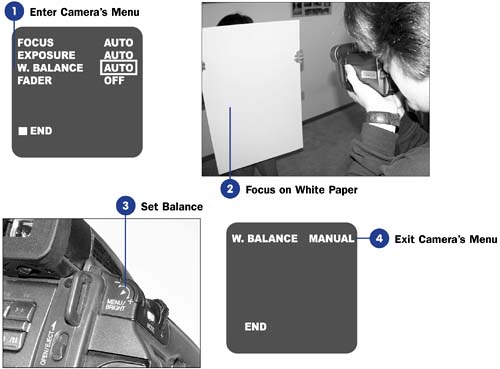15 White-Balance Your Scene Before You Begin  13 Light Your Video Properly 13 Light Your Video Properly
See Also  16 Take Low-Light Movies 16 Take Low-Light Movies
Video camcorders have to be tuned to the particular color of light in which you are filming . Otherwise, colors (such as some flesh tones) look wrong. When your camcorder knows what color white is, all the other colors come out accurately as well. This adjustment is usually done automatically, but you can get better results by manually white-balancing your camcorder ” especially indoors, in low-light situations, when using a camera light, or with unusually tinted overhead lights. Different light sources (such as light provided by sunrise , midday sun, candlelight, and fluorescent bulbs ) have different color temperatures , and this affects the way your camera displays color. An improperly balanced scene will appear reddish or bluish, depending on the color temperature. TIP  | For the most accurate video, balance your whites often and do not trust your camera's automatic controls any more than you have to. |
Remember to reset your white balance whenever conditions change. If you use manual white-balance settings from indoors when you film outdoors, you'll get unusual results. - Enter Camera's Menu
The exact procedure for balancing whites manually depends on the kind of camera you have but most white-balancing procedures are similar. Start by entering the White Balance menu and selecting manual mode.
- Focus on White Paper
Have someone hold a piece of bright, white paper in front of the camera. Position yourself so that the paper fills the frame and is in focus. Also, be sure that the paper is bathed in the light that you plan to shoot your subjects in so that you balance the camera properly.
- Set Balance
Refer to your camera's documentation to learn how to set the white balance. (The JVC camera in this picture uses the Menu dial to lock in the white balance.) Then select the appropriate control on your camera to memorize the paper's color value. This sets the white balance for the current lighting conditions.
 - Exit Camera's Menu
Finish the process by exiting the white balance menu by selecting the End or Exit option on your camera's menu. The camera is now set for filming. Remember that when you're done filming this scene, you should either set the camera back to automatic white balance or recalibrate the manual white balance for the next set of lighting conditions.
NOTE  | Now you might better understand why Hollywood movie production crews are so large! People are there to set white balance, set up lighting, set proper aperture, and so much more. The actual filming of a scene is simple once the rest is set up. | |


